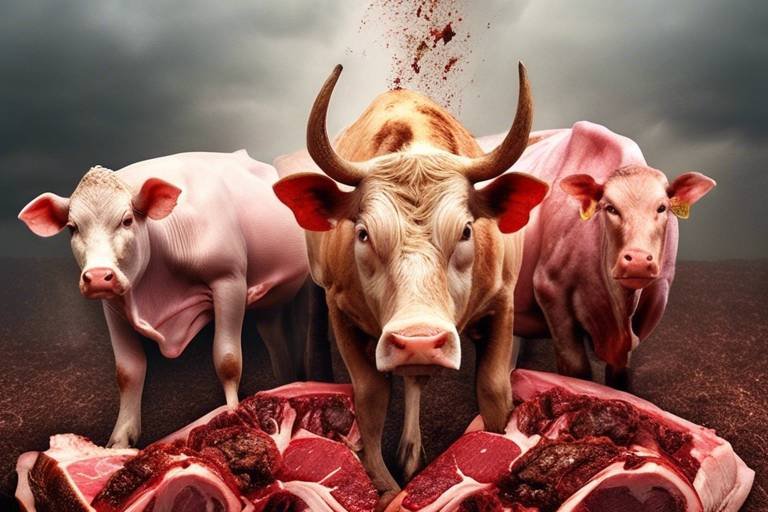The Impact of Meat Consumption on Our Environment
In today's world, the choices we make about our diets can have profound impacts on our planet. One of the most significant factors contributing to environmental degradation is meat consumption. As we delve into this topic, we will explore how our love for meat affects everything from greenhouse gas emissions to water usage, and even biodiversity. It's a complex web of consequences that often goes unnoticed. So, let's unravel this and see how our plates are linked to the health of our planet.
Have you ever considered that your dinner might be contributing to climate change? It's true! Meat production is a major player in the game of greenhouse gas emissions, especially when it comes to methane and nitrous oxide. These gases are far more potent than carbon dioxide, making their impact on global warming even more significant. Livestock, particularly cattle, produce methane during digestion, and the manure they leave behind releases nitrous oxide. According to the Food and Agriculture Organization (FAO), livestock accounts for approximately 14.5% of all human-induced greenhouse gas emissions. This staggering statistic highlights the urgent need for change in our eating habits if we want to combat climate change effectively.
Now, let’s talk about land. To meet the ever-growing demand for meat, vast tracts of forests are being cleared to make way for livestock farming. This not only leads to the loss of trees but also disrupts entire ecosystems. When forests are cut down, we lose more than just wood; we lose biodiversity, soil stability, and vital carbon sinks. In fact, the expansion of livestock farming is one of the leading causes of deforestation in sensitive areas like the Amazon rainforest. As we consume more meat, we are driving changes in land use that are detrimental to our planet's health.
The relationship between meat production and biodiversity is a critical one. When we clear forests for grazing or feed crops, we are effectively wiping out habitats for countless species. This loss of habitat threatens many animals with extinction. Just think about it: every time we choose a burger over a salad, we might be contributing to the decline of a species somewhere in the world. The ripple effect of our dietary choices can be profound, leading to an ecosystem that is less resilient and less capable of supporting life.
As forests are cleared for livestock, many species face the grim reality of extinction. For example, the Jaguar in South America is increasingly threatened by habitat loss due to cattle ranching. Similarly, the Sumatran Orangutan is losing its home to palm oil plantations, often linked to meat production. These are just two examples of how our meat consumption is directly tied to the fate of endangered species. It's a stark reminder that our food choices have far-reaching consequences.
Moreover, the deforestation driven by meat production disrupts vital ecosystem services that we often take for granted. These services include pollination, water purification, and climate regulation. For instance, when forests are cut down, we lose the natural habitats for pollinators like bees. This not only affects food production but can also lead to a decline in plant diversity. Similarly, forests play a crucial role in filtering water, and their loss can lead to poorer water quality. It’s a classic case of how interconnected our environment is, and how our dietary choices can ripple through various systems.
Another pressing concern is the water footprint of meat production. Did you know that producing just one kilogram of beef requires about 15,000 liters of water? That's enough to fill a small swimming pool! This staggering amount raises serious questions about water scarcity, especially in regions already facing drought. The water-intensive nature of meat production not only strains our water resources but also affects the availability of clean drinking water for communities around the world. As we think about our diets, we must consider the water implications of our food choices.
So, what can we do about this? Exploring sustainable alternatives to meat can significantly mitigate these environmental impacts. One option is to adopt a plant-based diet. Not only does this reduce our carbon footprint, but it also lessens the demand for land and water resources. However, transitioning to a plant-based lifestyle comes with its own set of challenges, including dietary preferences and cultural factors. Another innovative solution is lab-grown meat, which aims to replicate the taste and texture of traditional meat without the environmental toll. As technology advances, lab-grown meat could become a viable alternative, helping us enjoy our favorite dishes without harming the planet.
Making the switch to a plant-based diet can feel daunting, but it offers numerous benefits. Not only does it reduce greenhouse gas emissions, but it also promotes better health and well-being. While some may worry about missing out on their favorite meat dishes, there are countless delicious plant-based recipes that can satisfy even the most discerning palate. The challenge lies in changing our habits and perceptions about food. With a little creativity, we can create meals that are both satisfying and sustainable.
Lab-grown meat presents a fascinating frontier in the quest for sustainable food sources. This technology involves cultivating animal cells in a lab to create meat without raising and slaughtering animals. The benefits are substantial: reduced land use, lower greenhouse gas emissions, and less water consumption. While still in its infancy, lab-grown meat is gaining traction and could revolutionize the way we think about meat consumption. As we look to the future, embracing such innovations could be key to a more sustainable food system.
- What are the main environmental impacts of meat consumption? Meat consumption contributes to greenhouse gas emissions, deforestation, loss of biodiversity, and high water usage.
- How can I reduce my meat consumption? Consider incorporating more plant-based meals into your diet and exploring sustainable alternatives like lab-grown meat.
- Why is lab-grown meat considered a sustainable option? Lab-grown meat requires fewer resources and produces lower emissions compared to traditional meat production.
- What is the water footprint of different types of meat? Different meats have varying water footprints, with beef being the most water-intensive.

Greenhouse Gas Emissions
When we talk about , it’s hard to ignore the significant role that meat production plays in this global crisis. Did you know that the livestock sector is responsible for approximately 14.5% of all human-induced greenhouse gas emissions? This staggering figure primarily comes from two potent gases: methane and nitrous oxide. Methane, which is emitted during digestion in ruminants like cows and sheep, is over 25 times more effective at trapping heat in the atmosphere than carbon dioxide over a 100-year period. On the other hand, nitrous oxide, released from manure and synthetic fertilizers, is about 298 times more potent than carbon dioxide in terms of its heat-trapping ability. This means that our love for meat is not just a personal choice; it has serious implications for our planet.
To put this into perspective, let’s consider the emission footprints of various types of meat:
| Type of Meat | Greenhouse Gas Emissions (kg CO2e per kg) |
|---|---|
| Beef | 27 |
| Lamb | 39 |
| Pork | 12 |
| Chicken | 6 |
| Fish | 5 |
As you can see from the table, beef and lamb are the biggest culprits, emitting significantly more greenhouse gases compared to chicken or fish. This disparity highlights the importance of making informed dietary choices that can lead to substantial reductions in our carbon footprint. By opting for lower-emission proteins, such as chicken or plant-based alternatives, we can collectively make a difference.
Moreover, the environmental impact of meat consumption doesn't stop at emissions. The entire lifecycle of meat production—from feed production to transportation—contributes to the overall carbon footprint. For instance, the feed that livestock consume often comes from crops that require large amounts of fertilizers, which in turn release even more nitrous oxide into the atmosphere. It’s a vicious cycle that we need to break if we are serious about combating climate change.
So, what can we do about it? The first step is awareness. Understanding the relationship between our dietary choices and their environmental consequences is crucial. By reducing our meat consumption or opting for sustainably sourced options, we can help lower greenhouse gas emissions and promote a healthier planet.
In conclusion, the impact of meat consumption on cannot be overstated. It’s a pressing issue that requires immediate attention and action. As consumers, we hold the power to make choices that not only benefit our health but also contribute to the sustainability of our environment. Are you ready to take the plunge and explore more sustainable dietary options?

Deforestation and Land Use
The connection between meat consumption and deforestation is a complex web woven through our agricultural practices and dietary choices. As the demand for meat continues to rise globally, so does the need for more land to raise livestock. This insatiable appetite for meat has led to the clearing of vast areas of forests, particularly in regions like the Amazon rainforest, where trees are felled at an alarming rate. But why does this matter? Well, the forests are not just pretty backdrops; they are vital ecosystems that play a crucial role in maintaining our planet's health.
When we clear forests for livestock grazing or to grow animal feed, we are not only losing trees but also the myriad of species that depend on these habitats. The biodiversity that thrives in these forests is irreplaceable, and the loss of these natural habitats can lead to devastating consequences. Imagine the rich tapestry of life that exists within a forest, from the smallest insects to majestic mammals, all playing their part in a balanced ecosystem. When we cut down these forests, we are essentially pulling threads from this tapestry, creating gaps that can never be fully repaired.
Furthermore, the process of deforestation itself contributes to climate change. Trees act as carbon sinks, absorbing carbon dioxide from the atmosphere. When they are cut down, not only is this carbon storage capacity lost, but the act of burning or decomposing trees releases stored carbon back into the atmosphere, exacerbating the greenhouse gas problem. It’s like taking a deep breath of fresh air and then exhaling it into a smog-filled room; the balance is disrupted, and the consequences can be severe.
To put things into perspective, consider the following statistics:
| Type of Meat | Land Required (in hectares) per kg | Deforestation Impact |
|---|---|---|
| Beef | 20-30 | High |
| Pork | 6-7 | Moderate |
| Poultry | 4-5 | Low |
This table illustrates that beef production is particularly land-intensive, requiring significantly more land than other types of meat. The land used for grazing and feed production often comes at the cost of precious forests, leading to a vicious cycle of environmental degradation.
As we reflect on our choices, it’s essential to consider the broader implications of our dietary habits. The next time you sit down for a meal, think about where that meat came from and the impact it has on our planet. Are we willing to sacrifice our forests, our biodiversity, and our climate for a few moments of indulgence? The answer lies in our ability to make informed choices.
Deforestation not only affects the trees but also the countless species that rely on those trees for survival. As forests are cleared for livestock farming, we witness a dramatic decline in biodiversity. This section will delve deeper into the relationship between meat production, deforestation, and the alarming decline of various species.
As we continue to clear forests for grazing, many species face the grim reality of extinction. Iconic animals such as the Jaguar and the Orangutan are just a couple of examples of species that are losing their habitats due to livestock expansion. The loss of these species not only diminishes biodiversity but also disrupts the ecological balance, leading to unforeseen consequences.
Deforestation disrupts vital ecosystem services such as pollination and water purification. These services are essential for human survival and the overall health of our planet. When we consume meat at such high rates, we indirectly affect these services, putting our own wellbeing at risk. It’s a classic case of shooting ourselves in the foot: our dietary choices can have far-reaching impacts on the very systems that sustain us.
Meat production is water-intensive, raising concerns about water scarcity. This section will analyze the water footprint of various types of meat and its implications for global water resources.
Exploring sustainable alternatives to meat can help mitigate environmental impacts. This section discusses plant-based diets, lab-grown meat, and other innovative solutions.
Adopting a plant-based diet can significantly reduce environmental footprints. This section discusses the benefits and challenges of transitioning to a plant-based lifestyle.
Lab-grown meat presents a potential solution to traditional meat production's environmental issues. This subsection explores the technology, benefits, and current developments in lab-grown meat production.
- What are the main environmental impacts of meat consumption? Meat consumption contributes to greenhouse gas emissions, deforestation, and water usage, all of which have significant environmental consequences.
- How does meat production affect biodiversity? Meat production leads to habitat loss, which threatens various species and disrupts ecosystems.
- Are there sustainable alternatives to meat? Yes, options like plant-based diets and lab-grown meat are emerging as sustainable alternatives that can help reduce environmental impacts.

Impact on Biodiversity
The relationship between meat production and biodiversity is a critical one, and it’s not just a matter of numbers; it’s about the intricate web of life that sustains our planet. When we think about biodiversity, we often picture a vibrant tapestry of different species coexisting harmoniously, each playing a unique role in their ecosystem. However, the **expansion of livestock farming** has been likened to a bulldozer plowing through this delicate fabric, leaving behind a trail of destruction. As forests are cleared and wetlands drained for grazing land, countless species lose their homes, leading to a ripple effect that threatens the very balance of nature.
One of the most alarming aspects of this trend is the **direct correlation** between meat consumption and habitat loss. For example, the Amazon rainforest—often referred to as the "lungs of the Earth"—is being systematically dismantled to create space for cattle ranching. This not only results in the **loss of trees** that absorb carbon dioxide but also displaces countless creatures that depend on these ecosystems for survival. The **World Wildlife Fund** estimates that around 80% of deforestation in the Amazon is linked to livestock production. Imagine a bustling city suddenly losing its infrastructure; that's what happens to wildlife when their habitats are destroyed.
Furthermore, the decline in biodiversity is not just an environmental issue; it’s a **human issue** too. Biodiversity provides essential ecosystem services that we often take for granted, such as pollination, nutrient cycling, and even disease regulation. When species go extinct, these services can become disrupted, leading to consequences that can affect food security and human health. For instance, a decline in pollinators can lead to reduced crop yields, which means less food on our plates. It's a vicious cycle that highlights how interconnected we are with the natural world.
To put this into perspective, consider the following table that illustrates the **impact of livestock farming on various species**:
| Species | Habitat Loss (%) | Conservation Status |
|---|---|---|
| Jaguar | 50% | Near Threatened |
| Orangutan | 60% | Critically Endangered |
| Sumatran Rhino | 70% | Critically Endangered |
| Asian Elephant | 30% | Endangered |
As we can see, the statistics are staggering. These species, among many others, are not just numbers; they represent a **rich diversity of life** that is irreplaceable. The extinction of one species can lead to unforeseen consequences, impacting entire ecosystems and the services they provide. It’s like pulling a thread from a sweater; you might think it’s just one thread, but soon the whole thing starts to unravel.
In conclusion, the impact of meat production on biodiversity is profound and far-reaching. It’s not just about the animals we see on our plates; it’s about the entire ecosystem that supports life on Earth. We need to rethink our consumption patterns and consider the long-term effects of our dietary choices. After all, a healthier planet means a healthier future for all of us.
- What is biodiversity? Biodiversity refers to the variety of life on Earth, including the different species, ecosystems, and genetic variations.
- How does meat consumption affect biodiversity? Meat consumption drives habitat destruction, leading to the loss of species and ecosystems that are vital for a balanced environment.
- What can I do to help protect biodiversity? You can reduce your meat consumption, support sustainable farming practices, and advocate for policies that protect natural habitats.
- Are there alternatives to meat that are better for the environment? Yes, plant-based diets and lab-grown meats are sustainable alternatives that can significantly reduce environmental impacts.

Species Extinction
The alarming reality of species extinction is intricately tied to our insatiable appetite for meat. As we clear vast expanses of forests to make way for livestock grazing, we unwittingly push countless species to the brink of extinction. Imagine a vibrant forest, teeming with life—each tree, plant, and creature playing a crucial role in a delicate ecosystem. Now, picture that same forest reduced to barren land, stripped of its inhabitants. This isn't just a grim scenario; it's a reality that unfolds daily as meat production expands.
Take the Amazon rainforest, for instance. Often referred to as the "lungs of the Earth," it is home to an astonishing array of wildlife, including jaguars, sloths, and countless bird species. However, as cattle ranching becomes increasingly prevalent, large swathes of this vital habitat are decimated. According to recent studies, approximately 80% of deforestation in the Amazon is linked to cattle farming. This drastic change not only threatens the survival of iconic species but also disrupts the intricate web of life that depends on this ecosystem.
Furthermore, the species that are most vulnerable to extinction often have specialized habitats or diets, making them less adaptable to change. For example, the Sumatran orangutan relies heavily on the rainforest for food and shelter. As their habitat is destroyed for meat production, their populations dwindle. The loss of such species is not merely a statistic; it signifies a loss of biodiversity that can have far-reaching consequences. Biodiversity is essential for ecosystem resilience, and its decline can lead to the collapse of ecosystems that support human life.
It's also crucial to recognize that species extinction is not an isolated issue. The extinction of one species can lead to a domino effect, impacting other species and the services they provide. For instance, when pollinators like bees and butterflies disappear due to habitat loss, the plants they pollinate also suffer, leading to a decline in food sources for other animals and even humans. This interconnectedness illustrates why protecting species is vital, not just for their own sake but for the health of the planet.
To truly understand the gravity of this situation, consider the following table that highlights some endangered species directly affected by deforestation for meat production:
| Species | Habitat | Current Status |
|---|---|---|
| Sumatran Orangutan | Rainforests of Sumatra | Critically Endangered |
| Javan Rhino | Ujung Kulon National Park, Indonesia | Critically Endangered |
| Amazon River Dolphin | Amazons River Basin | Endangered |
| Golden Toad | Cloud forests of Costa Rica | Extinct |
As we examine these statistics and stories, it's evident that the choices we make regarding meat consumption have profound implications for the survival of our planet's biodiversity. By reducing our meat intake and advocating for sustainable farming practices, we can help mitigate this crisis. It's not just about saving individual species; it's about preserving the intricate balance of life on Earth that sustains us all.
- What is species extinction? Species extinction refers to the complete loss of a species from the planet, often due to habitat destruction, climate change, and human activities.
- How does meat consumption contribute to species extinction? Meat consumption drives deforestation and habitat destruction, which in turn leads to the loss of biodiversity and the extinction of various species.
- What can I do to help prevent species extinction? You can reduce your meat consumption, support sustainable farming practices, and advocate for policies that protect natural habitats.

Loss of Ecosystem Services
The connection between meat consumption and the loss of ecosystem services is often overlooked, yet it is critical to understand how these two factors intertwine. Ecosystem services are the benefits that humans derive from natural ecosystems, including pollination, water purification, carbon sequestration, and soil fertility. When forests are cleared for livestock farming, these services are severely disrupted, leading to a cascade of negative effects on the environment and human well-being.
One of the most alarming consequences of deforestation for meat production is the decline in pollination services. Many crops rely on pollinators like bees, butterflies, and birds to reproduce. As habitats are destroyed, these vital species face threats that can lead to their extinction. A decline in pollinator populations can result in reduced crop yields, meaning less food for our growing population and increased reliance on chemical fertilizers, which further harms the environment.
Moreover, the loss of forests impacts water purification. Forests act as natural filters, absorbing pollutants and providing clean water. When trees are removed, the ability of the land to filter water diminishes, leading to increased sedimentation and contamination of water bodies. This not only affects aquatic life but also poses a risk to human health, as communities may struggle to access clean drinking water.
Additionally, the disruption of natural habitats leads to the loss of carbon sequestration capabilities. Trees and plants absorb carbon dioxide, a major greenhouse gas, helping to mitigate climate change. When forests are cut down for grazing land, not only is this carbon storage capacity lost, but the carbon stored in trees is also released back into the atmosphere, exacerbating global warming.
Lastly, the degradation of soil health is another critical ecosystem service affected by meat production. Healthy ecosystems contribute to soil fertility by maintaining nutrient cycles and promoting biodiversity in soil organisms. Deforestation and overgrazing lead to soil erosion and nutrient depletion, making it increasingly difficult to grow crops sustainably. This cycle of degradation threatens food security and the livelihoods of farmers worldwide.
In summary, the loss of ecosystem services due to meat consumption is a multifaceted issue that affects not only the environment but also our health and food security. Understanding these connections is essential for promoting sustainable practices that can help preserve these invaluable services. As we consider the future of our diets, it is crucial to recognize the importance of maintaining healthy ecosystems for the well-being of both our planet and ourselves.
- What are ecosystem services? Ecosystem services are the benefits that humans receive from natural ecosystems, including clean air, water purification, pollination, and soil fertility.
- How does meat consumption affect biodiversity? Meat consumption drives deforestation for livestock farming, leading to habitat loss and threatening various species with extinction.
- What can be done to mitigate the loss of ecosystem services? Adopting sustainable agricultural practices, reducing meat consumption, and supporting reforestation efforts can help preserve ecosystem services.
- Why is water purification important? Clean water is essential for human health, agriculture, and maintaining healthy ecosystems. Disruption of natural filters due to deforestation can lead to water contamination.

Water Usage in Meat Production
Water is an essential resource for life, yet the amount used in meat production is staggering. Did you know that producing just one kilogram of beef can require over 15,000 liters of water? This figure is not just a number; it highlights a critical issue that affects not only the environment but also our future. As the global population continues to rise, the demand for meat escalates, leading to a significant strain on our water resources. The water footprint of meat production encompasses various stages, including feed crop irrigation, drinking water for livestock, and the water used in processing the meat itself.
The water footprint varies significantly between different types of meat. For instance, lamb and beef have the highest water consumption, while chicken and pork are relatively less water-intensive. To illustrate this disparity, consider the following table:
| Type of Meat | Water Footprint (liters/kg) |
|---|---|
| Beef | 15,000 |
| Lamb | 10,000 |
| Pork | 6,000 |
| Chicken | 4,000 |
This table clearly shows that the production of beef and lamb consumes an exorbitant amount of water compared to chicken and pork. The reasons for this are multifaceted. Firstly, cattle require a substantial amount of feed, which itself is produced through water-intensive crops. Secondly, the physiological needs of larger animals like cows mean they consume more water daily than smaller livestock. It's a vicious cycle that exacerbates water scarcity, particularly in regions already facing drought.
Moreover, the environmental impact of meat production extends beyond just water usage. The runoff from livestock farms can lead to water pollution, affecting both local ecosystems and human communities. Contaminated water sources can have dire consequences, including health risks and loss of aquatic life. This situation raises an important question: Is the environmental cost of our meat consumption worth the benefits?
Transitioning to more sustainable practices can help mitigate these issues. By adopting a plant-based diet or reducing meat consumption, we can significantly lower our water footprint. For instance, growing crops directly for human consumption requires far less water than raising animals for meat. This shift not only conserves water but also contributes to a healthier planet. In essence, every small change in our dietary choices can lead to substantial improvements in water conservation.
In conclusion, the water usage in meat production is a pressing concern that cannot be overlooked. As individuals and communities, we need to be aware of our water consumption and its broader implications on the environment. By making informed choices and supporting sustainable practices, we can help ensure that future generations have access to this vital resource.
- What is the water footprint of meat? The water footprint of meat refers to the total volume of freshwater used to produce meat, including water for feed crops, drinking water for animals, and processing.
- How does meat consumption affect water scarcity? Meat production is highly water-intensive, which can exacerbate water scarcity, especially in regions that are already experiencing drought.
- What are some sustainable alternatives to meat? Plant-based diets, lab-grown meat, and reducing overall meat consumption are some sustainable alternatives that can help mitigate environmental impacts.

Sustainable Alternatives to Meat
As we grapple with the pressing environmental issues stemming from meat consumption, the search for sustainable alternatives becomes increasingly vital. The good news is that there are numerous options available that not only cater to our dietary preferences but also significantly reduce our environmental footprint. From plant-based diets to innovative technologies like lab-grown meat, the alternatives are both exciting and practical.
First, let’s dive into the world of plant-based diets. Transitioning to a diet rich in fruits, vegetables, legumes, and grains can be a game-changer. Not only do these foods require far less land and water to produce, but they also generate fewer greenhouse gases compared to traditional livestock farming. For instance, a study has shown that if everyone in the U.S. reduced their meat consumption by half, it would be equivalent to taking 25 million cars off the road! However, the shift to a plant-based diet isn’t without its challenges. Some people may find it difficult to give up meat entirely, while others might struggle with ensuring they get all the necessary nutrients, such as protein and vitamins. But with a bit of planning and creativity, anyone can enjoy a delicious and nutritious plant-based meal.
Next up is the exciting realm of lab-grown meat. This innovative approach to meat production involves cultivating animal cells in a lab, allowing us to enjoy the taste and texture of meat without the environmental drawbacks. Imagine biting into a juicy burger that didn't require the raising and slaughtering of livestock! The benefits of lab-grown meat are numerous, including reduced land use, lower greenhouse gas emissions, and a significant decrease in water consumption. While this technology is still in its infancy, advancements are being made rapidly. Companies around the world are racing to bring lab-grown meat to the market, and it’s projected that it could become a viable option in the next few years.
Additionally, there are various plant-based meat substitutes available today, made from ingredients like soy, pea protein, and mushrooms. These products are designed to mimic the taste and texture of traditional meat, making it easier for those who are hesitant to make a complete switch. Some popular brands have even garnered a cult following, proving that plant-based options can be just as satisfying as their meat counterparts. However, it's essential to read labels and choose options that are minimally processed and rich in nutrients.
In summary, the shift towards sustainable alternatives to meat is not just a trend; it’s a necessary evolution in our dietary habits. By embracing plant-based diets, exploring lab-grown meat, and opting for plant-based substitutes, we can collectively make a significant impact on our planet. The journey might seem daunting at first, but every small change counts, and together, we can pave the way for a more sustainable future.
- What are the health benefits of a plant-based diet? A plant-based diet can lower the risk of chronic diseases, improve heart health, and promote weight loss.
- Is lab-grown meat safe to eat? Yes, lab-grown meat undergoes rigorous testing and regulation, similar to traditional meat products.
- Can I get enough protein from a plant-based diet? Absolutely! There are plenty of plant-based protein sources, including legumes, nuts, seeds, and whole grains.
- What are some popular plant-based meat alternatives? Some popular options include Beyond Meat, Impossible Foods, and various brands of tempeh and tofu.

Plant-Based Diets
Adopting a plant-based diet is more than just a trend; it’s a lifestyle choice that can have a profound impact on our environment. Imagine replacing that juicy steak with a vibrant plate of quinoa, black beans, and fresh vegetables. Not only does this shift reduce your carbon footprint, but it also opens the door to a healthier way of living. By choosing to consume more plants, we can significantly decrease the demand for meat, which in turn lessens the strain on our planet's resources.
One of the most compelling arguments for transitioning to a plant-based diet is the sheer reduction in greenhouse gas emissions. According to research, the production of plant-based foods generally emits fewer greenhouse gases compared to meat production. For instance, producing a kilogram of beef can generate up to 27 kilograms of CO2 equivalent, while a kilogram of lentils might only produce about 0.9 kilograms. This staggering difference illustrates how our dietary choices can either contribute to or help mitigate climate change.
However, transitioning to a plant-based lifestyle isn’t without its challenges. Many people find it difficult to let go of familiar flavors and textures associated with meat. But fear not! There are countless delicious alternatives available today. From tofu and tempeh to jackfruit and seitan, the options are diverse and can easily satisfy even the most devoted meat-lover's cravings. Plus, with the rise of innovative culinary techniques, you can replicate the taste of meat in a plant-based format, making the transition smoother and more enjoyable.
Moreover, a plant-based diet is not just beneficial for the environment; it can also significantly improve your overall health. Research suggests that individuals who consume more fruits, vegetables, whole grains, and legumes tend to have lower risks of chronic diseases such as heart disease, diabetes, and certain cancers. So, not only are you doing your part for the planet, but you’re also investing in your own well-being!
For those looking to make the switch, here are a few practical tips:
- Start Slow: Begin by incorporating more plant-based meals into your week. Try “Meatless Mondays” or replace one meat dish at a time.
- Explore New Recipes: The internet is full of creative and delicious plant-based recipes. Dive into the world of vegan cooking and discover new flavors.
- Join a Community: Engaging with others who are transitioning to plant-based diets can provide support, inspiration, and motivation.
In conclusion, embracing a plant-based diet is a powerful way to contribute to a more sustainable future. By making conscious choices about what we eat, we can reduce our environmental impact while reaping the health benefits that come with a diet rich in plant foods. So, why not give it a try? Your taste buds, health, and the planet will thank you!
Q: What are the health benefits of a plant-based diet?
A: A plant-based diet is associated with lower risks of chronic diseases, improved heart health, and better weight management.
Q: Do I need to completely eliminate meat from my diet?
A: No, you can start by gradually reducing meat consumption and replacing it with plant-based alternatives.
Q: How can I ensure I’m getting enough protein on a plant-based diet?
A: There are plenty of plant-based protein sources such as beans, lentils, tofu, quinoa, and nuts.
Q: Is it expensive to eat a plant-based diet?
A: While some specialty items can be pricey, staples like grains, beans, and seasonal vegetables are often more affordable than meat.

Lab-Grown Meat
Lab-grown meat, also known as cultured or cell-based meat, is revolutionizing the way we think about food production and its environmental impact. Imagine being able to enjoy a juicy burger without the ethical concerns or environmental degradation associated with traditional meat farming. Sounds too good to be true? Well, it’s becoming a reality! This innovative technology involves cultivating animal cells in a controlled environment, allowing us to produce meat without raising and slaughtering animals. The process not only addresses ethical issues but also significantly reduces the negative environmental impacts linked to conventional meat production.
One of the most compelling aspects of lab-grown meat is its potential to drastically lower greenhouse gas emissions. According to research, traditional meat production is responsible for a staggering percentage of global emissions, primarily due to methane released by livestock and the energy-intensive processes involved in raising animals. In contrast, lab-grown meat can reduce these emissions by up to 90%, making it a more sustainable option for our planet. But how does this process work?
In the lab, scientists take a small sample of animal cells and place them in a nutrient-rich culture medium that allows them to grow and multiply. This method can produce muscle tissue that mimics the texture and flavor of conventional meat. The technology is still in its infancy, but companies are making strides in scaling up production and improving the taste and texture of lab-grown products. The fascinating part is that lab-grown meat can be tailored to meet specific nutritional needs, providing a healthier alternative to conventional meat.
However, the journey to widespread adoption of lab-grown meat is not without its challenges. One of the main hurdles is the cost of production, which, although decreasing, still remains higher than that of traditional meat. As technology advances and economies of scale come into play, we can expect prices to drop, making lab-grown meat more accessible to the average consumer. Furthermore, regulatory hurdles and public perception are significant factors that will influence the acceptance of lab-grown meat in mainstream diets.
In addition to environmental benefits, lab-grown meat also has the potential to enhance food security. With the global population projected to reach 9.7 billion by 2050, the demand for protein sources will skyrocket. Lab-grown meat could provide a sustainable solution to meet this demand without overexploiting our planet's resources. It's a game-changer that could help us avoid the pitfalls of conventional agriculture, which often leads to deforestation, water scarcity, and loss of biodiversity.
In conclusion, lab-grown meat represents a promising alternative to traditional meat production. By adopting this innovative approach, we can enjoy our favorite foods while taking significant steps toward a more sustainable and ethical food system. As we continue to explore and embrace these technologies, we may very well be on the brink of a food revolution that benefits both our health and the health of our planet.
- Is lab-grown meat safe to eat? Yes, lab-grown meat undergoes rigorous testing and regulatory scrutiny to ensure it is safe for consumption.
- How does lab-grown meat compare in taste to traditional meat? Many taste tests have shown that lab-grown meat can closely replicate the taste and texture of conventional meat, though it's still being refined.
- Will lab-grown meat replace traditional meat? While it may not completely replace traditional meat, it offers a sustainable alternative that can coexist alongside it.
- What are the environmental benefits of lab-grown meat? Lab-grown meat has the potential to reduce greenhouse gas emissions, land use, and water consumption compared to conventional meat production.
Frequently Asked Questions
- What are the main environmental impacts of meat consumption?
Meat consumption has several significant environmental impacts, including high greenhouse gas emissions, deforestation, and excessive water usage. The production of meat, particularly beef, generates methane and nitrous oxide, which are potent greenhouse gases. Additionally, livestock farming contributes to deforestation as forests are cleared for grazing land, leading to habitat loss and decreased biodiversity.
- How does meat production contribute to climate change?
Meat production contributes to climate change primarily through the release of greenhouse gases during the digestive processes of livestock, as well as from manure management and feed production. The methane emitted by cattle is particularly concerning, as it has a much higher global warming potential than carbon dioxide. By understanding these emissions, we can better address climate change and promote more sustainable agricultural practices.
- What is the relationship between meat consumption and deforestation?
The relationship between meat consumption and deforestation is closely linked. As demand for meat increases, more land is needed for livestock grazing and growing animal feed, leading to the clearing of forests. This deforestation not only destroys habitats but also contributes to the loss of biodiversity, as many species are pushed to the brink of extinction due to habitat loss.
- How does meat production affect water resources?
Meat production is incredibly water-intensive, requiring vast amounts of water for animal hydration, feed crops, and processing. The water footprint varies by type of meat, with beef typically requiring the most water. This raises concerns about water scarcity, especially in regions already facing water stress. Reducing meat consumption or opting for more sustainable alternatives can help alleviate pressure on global water resources.
- What are some sustainable alternatives to meat?
There are several sustainable alternatives to meat that can help reduce environmental impacts. Plant-based diets are gaining popularity as they tend to have a lower environmental footprint compared to meat-based diets. Additionally, lab-grown meat is emerging as a potential solution, offering a way to produce meat without the associated environmental costs of traditional livestock farming.
- What are the benefits of adopting a plant-based diet?
Adopting a plant-based diet can significantly reduce your environmental impact, as it typically requires fewer natural resources and generates lower greenhouse gas emissions. Beyond environmental benefits, plant-based diets can also improve health by reducing the risk of chronic diseases. However, transitioning to a plant-based lifestyle may come with challenges, such as ensuring adequate nutrition and finding suitable food options.
- What is lab-grown meat, and how does it work?
Lab-grown meat, also known as cultured or cell-based meat, is produced by culturing animal cells in a lab rather than raising and slaughtering animals. This innovative technology aims to replicate the taste and texture of traditional meat while minimizing environmental impacts. Current developments in lab-grown meat show promise for providing a more sustainable and ethical alternative to conventional meat production.



















